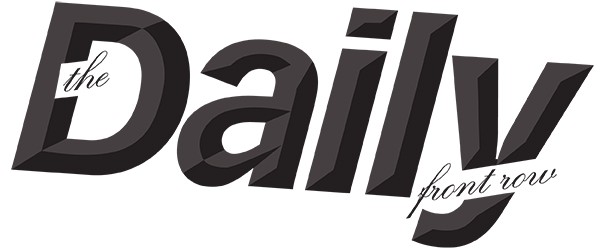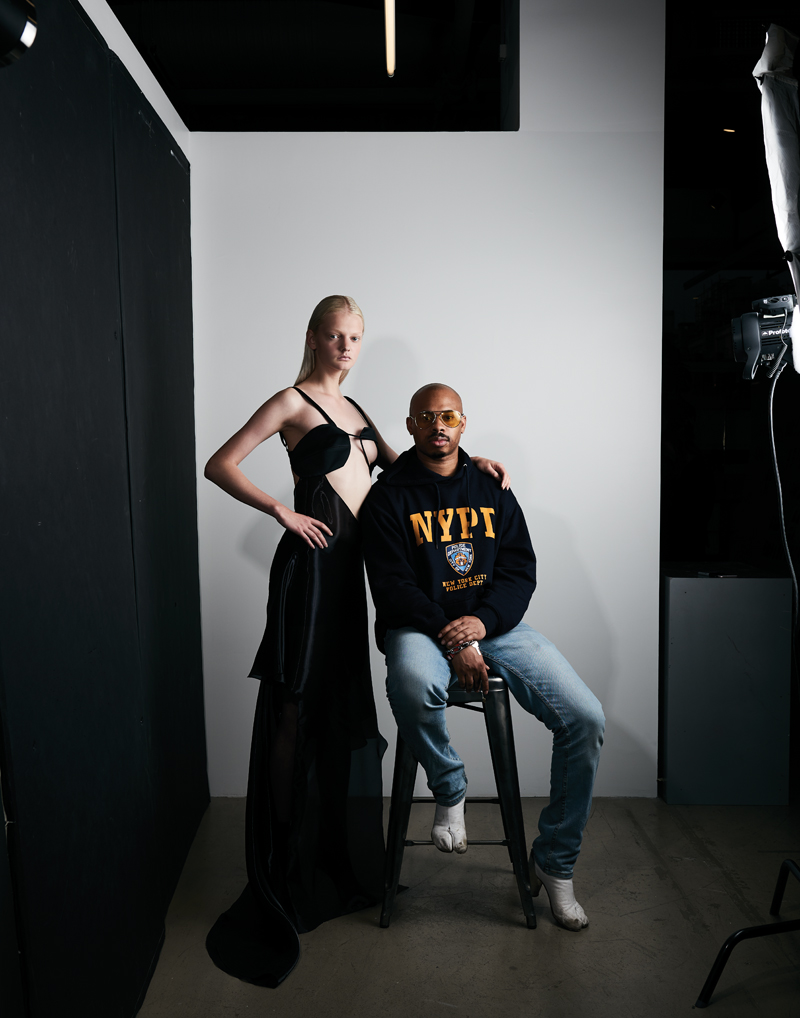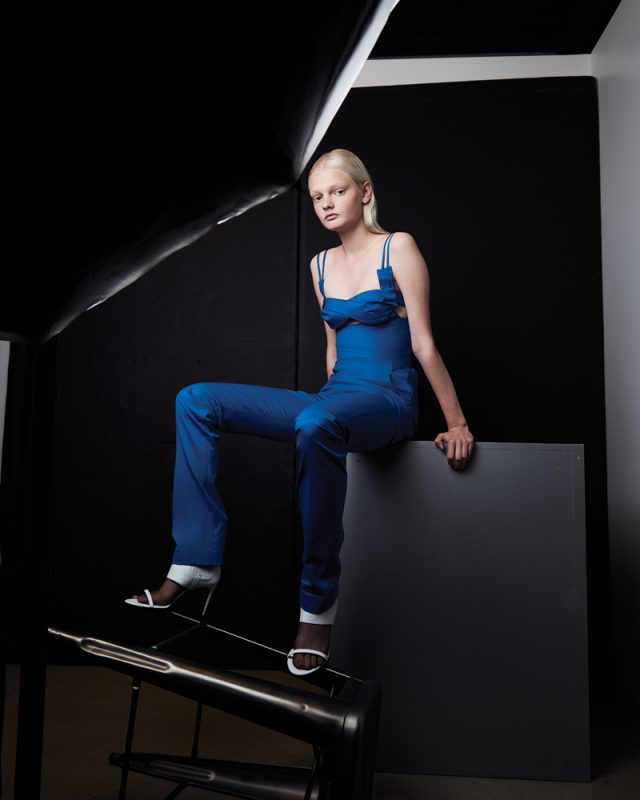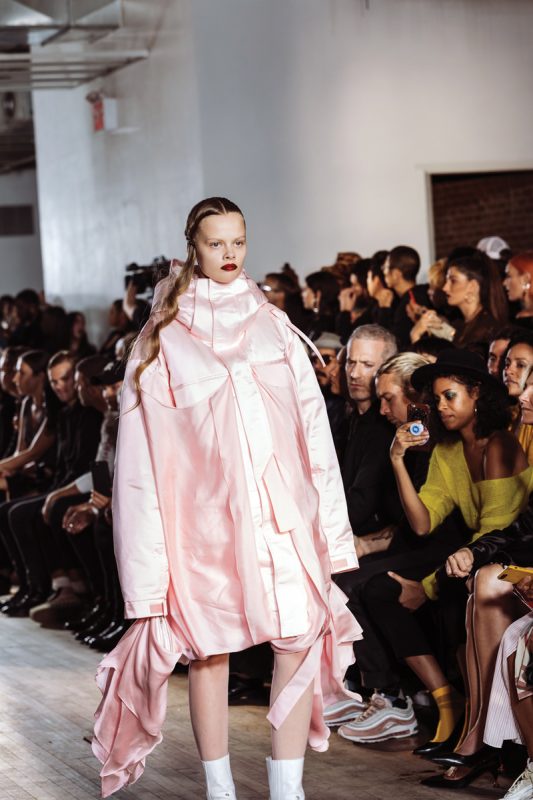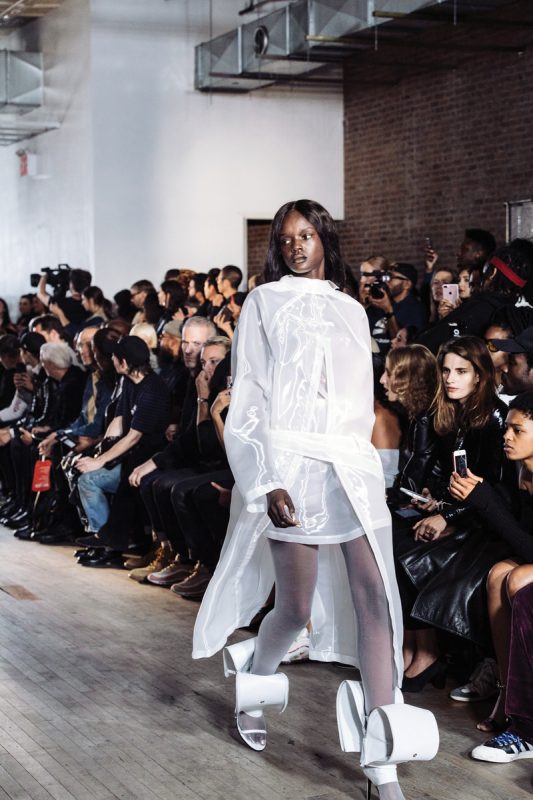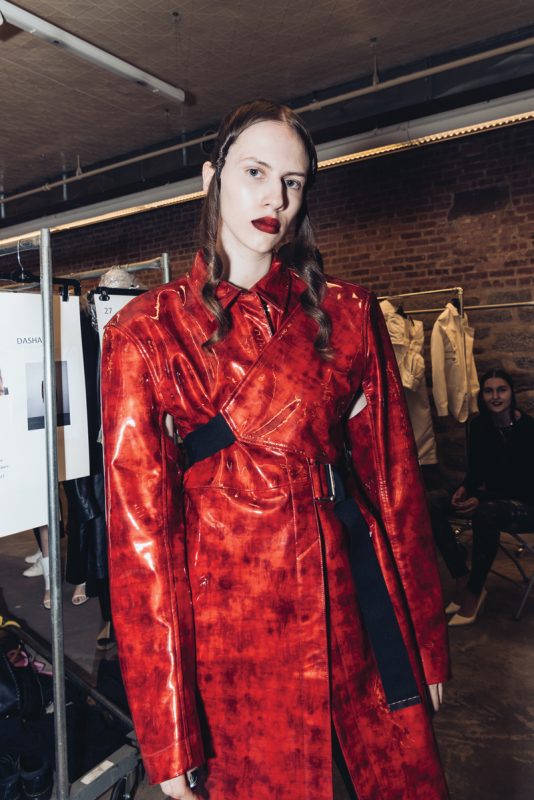In his Twenties, Shayne Oliver’s Hood by Air was the darling of New York’s young designer scene. So when the now-30-year-old designer put HBA on hiatus, everyone wondered: What’s next? Before long, Oliver was tapped by Isabella Burley, Helmut Lang’s new editor in residence, to reinvent the brand for spring 2018. On Monday night, he unveiled Helmut Lang’s Seen by Shayne Oliver, to the delight of his fans around the globe.
Shayne, how did you meet Isabella Burley?
Isabella had been covering the shows, so I had known her for a while. I’d see her everywhere. We’d hang out, bond and stuff like that. One day, Akeem [Smith, Oliver’s stylist] told me that she wanted to speak to me about a project. What’s so funny is that I had been asking around about the brand to find out who was doing stuff there.
And that was when?
In November of last year. I began working on the concepts in January and then I began working on this specific runway collection in late April and early May.
How much did you consider the Helmut Lang DNA when you were designing?
I tried to get into it, but it’s not that easy because, of course, he destroyed most of it. [Helmut Lang, now considered a fine artist, shredded a reported 6,000 garments sometime in 2010 or 2011.] I went based upon how things he did felt to me—buying it on my own and looking at the things I own and how I wore them over the years, and how people in New York around me interacted with the brand. I was also interested in the idea of pornography in the clothing, and how it exudes or fetishizes the human itself. I brought in all the mandatory items you would need in a fetishized world, and went from there. It’s about nailing the vibe.
Were there specific seasons that you were into?
The first thing that came to mind for me was the collection with the metallic skirts that were made out of suit jackets and shirts and fold-over fanny packs. That resonated with where I left off with Hood By Air. From there I sort of let go, because when I saw some of the physical pieces, they were so conceptual they were, like, deteriorating, and so that also became a concept. You make amazing things, but they deteriorate and they collapse, so it’s really about capturing a moment.
A lot of people would say that you have really captured a moment in fashion since you came on the scene.
I’m so happy that people say that now. When we stopped HBA, we felt like we were putting our all into it, and it was still being recognized not in this unappreciated way, but I would say…a junior way. We were creating new formulas and new ways of thinking, so you can’t really be junior if you’re creating it. Obviously, it was never really about craftsmanship for us, but I guess because our ideas were so elevated, it was looked at in that context. When we came here and saw the level of craftsmanship we were like, “Oh. That’s so crazy.” When we look back on some of those HBA pieces, they hardly hold together. It’s a full-circle moment for sure.
How do you feel when you see your influence on so many other big runways?
To be honest, it’s a little infuriating. But also I realize I’m just now turning 30, so I’m grateful that I’ve had that moment to do that. I hope I’ll continue to stay gracious enough to realize that I did these things while I was pretty young, and now I can master it, and be able to know what I want and don’t want from my past.
For example…
I really want to have a business partner who really knows how to engage with the work and is efficient. I think the weird thing about fashion right now is that you can sell a broken skateboard to someone if you market it correctly. That’s a lost art. People don’t realize that runway fashion is based on people who took those ideas and made it into ready-to-wear. What I need in order to move forward is someone who can take those ideas and make them marketable to the consumer. You can create ideas all day, but you need them to be well managed and orchestrated correctly. It’s all about the management of ideas, to be honest.
What would you want to hold on to ideally?
It’s really fun having a hold of the youth. The youthful energy is great. When I don’t have it I feel weird. It really comes along with that territory, this idea of curating a group of younger individuals and understudies. That’s what I would love to do. At HBA, it became like a school almost. I was learning from them as well. It was a bit of a tit for tat, and I really loved that. I loved being able to push and show them things. I don’t want to be a lone designer by myself in the atelier in some austere way. Akeem is now an individual in fashion and has made a name for himself, and I feel like now that they’ve all had the chance to do that, I want them to come back here. Back then we were so young [that] people weren’t known yet outside of the clique, but now they are.
Now you all need a bigger stage.
Exactly. So at Helmut Lang, it’s been intriguing to work with someone’s history. That was cool. Until I can find a person to work with on the ideas that I specifically want to work with independently or under HBA, I really appreciate this idea of working toward a goal for someone else’s house…not someone else’s house, because who even knows what that means at this point. There aren’t that many houses to take over or to work with. New York is so stiff. I was just talking about this earlier—in Europe, they seem to know that there needs to be change, and they need to hand it over. The New York kids—we’re still being influential, but we’re not at the forefront taking the reins. That’s why I thought it was so cool on Andrew [Rosen]’s part to bring me on. Whenever I go to him with ideas, he’s down with them.
What have been the pros and cons of working for a more corporate fashion brand?
I have way more confidence as a designer. [At HBA] there were too many financial opinions that actually weren’t based in truth, because no one was a financial genius. Whereas here, you’re chosen to be a designer, and that’s what’s expected of you.
Did they give you freedom to execute most of your ideas?
I think with us, we’re temperature readers. So you can feel when they’re not going to go for something. and then you know exactly which ideas you want to push for. It’s good because it helps you engage which ideas are actually important to you and which ideas you can let go. I also wanted to be respectful—I can save some of the bigger ideas for projects that are all about me. Here it’s more about bringing things to the table that I’ve become familiar with and blending them with the DNA of the brand.
Has being at Helmut Lang felt more free?
Totally. This is a vertical business structure, and we’re inserted into it. That feels much healthier as opposed to the idea that everything is about us. Also, there are so many different lines at Helmut Lang. There’s the main line, then there’s Seen by Shayne Oliver, which is a specific runway line, and there’s the re-edition collection, which is based on the past.
What was the first piece from Helmut that you bought?
It was a pair of black trousers that look like they are inside out. I still have them and I remade them here. Another thing we really gravitated to here was how elegant Helmut Lang was. To me, that’s what he made more modern—the way you wear formal clothes and how you thought about a blazer and a suit and how you wore a dress. At HBA, we did extreme puffers and heavy outerwear, so we took some of those designs and brought those here and mixed them in with the eveningwear ideas.
Tell us about the accessories.
A lot of things at HBA didn’t make it to market. We didn’t have the resources. It’s not that they couldn’t be made, but if everyone was buying the T-shirt we had to spend our money on that. It all had to go back to making the T-shirts. So now here, we have things like these bra-based bags. Initially, they were only going to be for photos but then sales loved them and they went into production. At HBA, everything was a statement piece. Here, we started out with the basics of the wardrobe and then added statement pieces, so it’s reversed.
Do you still work out of your studio? The one with the hot tub?
[Laughs] No, we shut down that space. We’re going to start fresh after the show and figure it out. Also, all of us are so independent that in the last days, it didn’t even make sense to have the space because we were all over the place and traveling so much. Where the magic happens is when we finally get into a room together, as opposed to always being in the same room. This is how people think about things now, in a lot of different ways. Maybe it’s not based on being in an office with the same people every day anymore. The thing with HBA is it began to weigh down on me and was also financially stressful and culturally a huge burden. It just felt heavy.
Your mother has been a huge influence on your life. What does she think of your success?
She’s into it. She’s always been proud and always in it. She’s protective. She’s still influential to me. We influence each other. We’ll go back and forth about outfits and inspiration. Her feeling about everything is that she just wants to keep me safe and protected. HBA was my home, and now I’m being pushed into arenas where I’m not familiar. She’s a momager.
Is there anyone you cast in the show that you’re really excited about?
There’s this girl, Lola, who I found at a restaurant. She’s really cute and young and adorable and really sexy. I just really like her. She doesn’t take no s**t. She works around all guys and she holds her ground while being extremely attractive and sexual. And it’s not a give and take—you get it all at once. It’s rare to see that kind of energy happen.
What restaurant did you find her in?
Lucien in the East Village. We’ve been hanging out there ridiculously this past fall and winter. It was basically the nightclub of the fall.
Lucien is very small to be a nightclub!
I know! But everyone now is very into these dinners. It’s symbolic of where everyone is at right now. Let’s sit down and actually talk to each other over a certain amount of music. The cultural vibe is still there, but you’re actually interacting with each other. It’s refreshing and nice and mature, I guess.
Music is a big part of your scene. What is your design soundtrack?
It definitely is. I’ve been listening to this French band called Sexy Sushi, and I’ve been getting into a lot of death rock, specifically female vocalists.
How has the cultural vibe shifted since you began your career?
I think everyone now is looking at the archive of what we did and picking what they like the most out of it and taking those things and translating them into their sphere. As far as the overall vibe, true blue remains true blue. We’re all still there. It’s more like we’re family now. Now we’re all thinking about things like finding a real apartment, whether or not we’re going to stay in New York, and things like that. We’re all growing up.
Makeup & hair by Aeriel Payne
